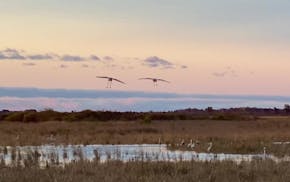I've been writing gardening articles for the Star Tribune for more than 30 years, and while I love being able to share information with home gardeners, I've been retired from the University of Minnesota — the source of the newest and best garden advice — for several years. So, I think it's time to bow out — gracefully, I hope.
Rather than passing on any final words of wisdom, I'm going to share the names of a few of my favorite plants — ones I love because they've proven both rewarding and relatively easy to grow. And while I'm at it, I'd like to salute a few of my favorite Twin Cities gardens.
Trees
Two trees top my list; flowering crabapples and bur oaks.
Though there are newer varieties, Prairie Fire remains my favorite crabapple. It has all the positive attributes and none of the negative ones sometimes associated with crabapple trees. Prairie Fire is gorgeous when covered with rosy blossoms late in May, and its burgundy/bronze foliage stays nice all summer. By fall, little, dark-red crabapples are visible, hanging in the tree until late winter or early spring, when hungry birds swoop in and feast on them. No messy, fermenting fruit on the ground by these trees.
Years ago, when Dutch elm disease claimed all the trees on my Prospect Park boulevard, three stately bur oaks kept my house and yard comfortably shaded. Though some people dislike them because they're likely to drop enormous amounts of acorns every few years, bur oaks are beautiful trees. Granted, their leaves don't turn a spectacular fall color. In fact, it's only after they drop their leaves that you can truly appreciate their sculptural form, which provides so much landscape interest in winter. On the downside, bur oaks are extremely slow-growing. I was lucky enough to live in a house that already had mature trees in the yard.
Indoor plants
In our climate, houseplants that bloom in winter and early spring are truly wonderful. Amaryllises and moth orchids (Phalaenopsis species) are my favorites. Though amaryllis bulbs, with their long strap-like leaves, aren't much to look at when they're not blooming, their spectacular large blossoms more than make up for it. And when treated as sun-loving houseplants, they'll bloom year after year.
Showy moth orchids, once the province of orchid hobbyists and the well-to-do, are widely available now at budget prices. If one starts to look scraggly, I just toss it and buy another. Like amaryllises, they're attractive only when in bloom. Moth orchids are prized for their long-lasting, butterfly-shaped flowers (I've had individual blossoms last three or four months), and they're among the easiest of houseplants to care for.
It's more difficult to name a favorite houseplant that's grown for its foliage, rather than flowers. My choice is Chinese evergreen, a slow-growing plant with modest light and water requirements — a true low-maintenance plant. Most Chinese evergreen leaves have some combination of silver, green or ivory, but newer varieties may include red or pink variegations.
Shrubs
I'm in a quandary. Although hardy shrub roses are my absolute favorites, one of mine that's been perfectly hardy and has performed beautifully for the past eight years did not survive this winter. Thorny as all get out, it's going to be a beast to remove. Plus, the arrival of hordes of hungry Japanese beetles several years ago raises the annual question of whether hardy roses will bloom fully before the beetles emerge from the ground to begin feeding.
Gardens
Clearly, the Minnesota Landscape Arboretum is the largest, most magnificent of gardens in the Twin Cities area. It's really a collection of gardens, with something for everyone — from tiny wildflowers to mammoth trees — all changing throughout the seasons.
But I also have a couple of favorite smaller gardens.
First is the Japanese garden in St. Paul's Como Park, which offers a cool, serene refuge in the heart of the city — a lovely place to stroll around the pond, then sit and relax on a warm summer day.
My other favorite is Noerenberg Gardens, on the shore of Lake Minnetonka. Its perennial beds feature flowers, shrubs, ornamental grasses and even an occasional vegetable, combined in creative and interesting ways. While most gardens tilt toward spring and early summer beauty, Noerenberg reaches its peak later in summer when clusters of giant Joe Pye weed are in full bloom.
Flowering annuals and perennials
This is a good place to sign off, because I couldn't possibly choose any favorites to highlight. I love them all!

A Minnesota field guide to snow shovels: Which one's best?
Sign up for Star Tribune newsletters

